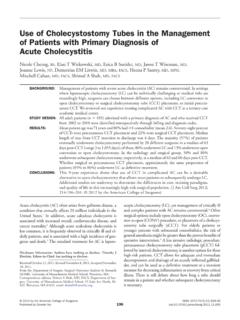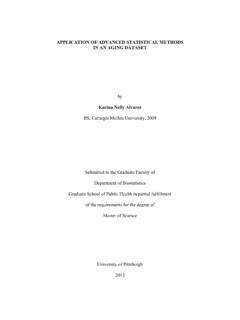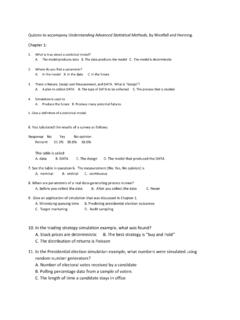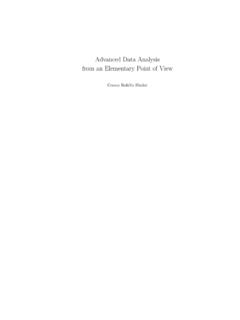Transcription of ADVANCED STATISTICAL METHODS: PART 2: …
1 ACS Outcomes Research Course ADVANCED STATISTICAL methods 1 ADVANCED STATISTICAL methods : part 2: INTRODUCTION TO MULTILEVEL MODELING IN STATA Learning objectives: 1. To understand that multilevel modeling is an important regression technique for analyzing clustered data ( , patients clustered in hospitals), which is commonly encountered in surgical outcomes studies. 2. To appreciate that multilevel models have many other practical applications, including profiling hospital quality and decomposing hospital-level variation in outcomes. 3. To create multilevel models in STATA and then evaluate the usefulness of a random effects model to determine how much hospital-level variation in outcomes after cardiac surgery is explained by patient risk factors.
2 MULTILEVEL MODELS IN STATA: Open the new dataset and summarize the data For this analysis, we will use a modified version of the Maryland coronary artery bypass surgery dataset used in earlier labs ( ). This new dataset has hospital-level variables that are necessary for this exercise. We will be creating a multilevel model with 2 levels: 1) patient and 2) hospital. The patients are clustered within 10 hospitals and we will use a hospital identifier to specify this relationship in our laboratory exercise. Type the command: summarize STATA output: Variable | Obs Mean Std. Dev. Min Max -------------+-------------------------- ------------------------------ key | 4668 +13 0 +13 +13 age | 4668 16 94 atype | 4650.
3 8960876 1 6 died | 4661 .0281056 .1652922 0 1 female | 4668 .3018423 .4591064 0 1 -------------+-------------------------- ------------------------------ los | 4668 0 114 pay1 | 4644 1 6 pr1 | 0 Npr1 | 4668 3610 3619 race | 4654 1 6 -------------+-------------------------- ------------------------------ totchg | 4668 4422 355980 hosp | 4668 1 10 volume | 4668 1 999 ACS Outcomes Research Course ADVANCED
4 STATISTICAL methods 2 You should notice two new variables, hosp and volume, which represent the hospital number (1 to 10) and the annual hospital volume (range 1 to 999), respectively. Exploring the hospital volume mortality relationship We will first explore the relationship between hospital volume and mortality in this dataset. To obtain a rough idea of whether volume is important, we will divide hospitals into two groups, high and low volume. Begin by summarizing the volume variable. Type the command: summarize volume STATA output: . sum volume Variable | Obs Mean Std. Dev. Min Max -------------+-------------------------- ------------------------------ volume | 4668 1 999 We can then create a new variable, highvol, using the mean as a cutoff and tabulate the results.
5 Type the commands: gen highvol=1 if volume>662 replace highvol=0 if highvol ~=1 tab highvol STATA output: . tab highvol highvol | Freq. Percent Cum. ------------+--------------------------- -------- 0 | 2,856 1 | 1,812 ------------+--------------------------- -------- Total | 4,668 This output shows that 39% of patients have surgery in high volume hospitals, as defined by a volume above 662 cases. ACS Outcomes Research Course ADVANCED STATISTICAL methods 3 Next we will determine whether high volume hospitals have lower mortality rates in Maryland.
6 Type the commands: tab died highvol, chi col STATA output: Died | during | hospitaliz | highvol ation | 0 1 | Total -----------+----------------------+----- ----- Alive | 2,763 1,767 | 4,530 | | -----------+----------------------+----- ----- Dead | 86 45 | 131 | | -----------+----------------------+----- ----- Total | 2,849 1,812 | 4,661 | | Pearson chi2(1) = Pr = The results show that high volume hospitals have lower mortality ( vs.)
7 But this result does not reach STATISTICAL significance in a chi square test (P= ). However, this test of significance is based on a dichotomous volume variable, which is not ideal. When you make a continuous variable into a dichotomous variable you lose information. To test the true significance of volume, we will generate a new variable log(volume), as this is the typical relationship between volume and mortality. Type the commands: gen logvol=log(volume) Now we will evaluate the significance of logvol using simple logistic regression. Type the commands: logistic died logvol ACS Outcomes Research Course ADVANCED STATISTICAL methods 4 STATA output: Logistic regression Number of obs = 4661 LR chi2(1) = Prob > chi2 = Log likelihood = Pseudo R2 = ---------------------------------------- -------------------------------------- died | Odds Ratio Std.
8 Err. z P>|z| [95% Conf. Interval] -------------+-------------------------- -------------------------------------- logvol | .7345641 .1126422 .5438782 .9921054 ---------------------------------------- -------------------------------------- In this analysis, hospital volume has a statistically significant relationship to mortality (P= ). But this relationship is relatively weak, especially compared to other procedures ( , esophagectomy and pancreatectomy), which is consistent with the published literature. Creating a multilevel model We will now introduce the commands for creating multilevel logistic regression models in STATA.
9 The basic command is xtmelogit. We will first create a model that includes no fixed effects ( , no patient characteristics) and a hospital random effect: Type the commands: xtmelogit died || hosp: STATA output: Mixed-effects logistic regression Number of obs = 4661 Group variable: hosp Number of groups = 10 Obs per group: min = 1 avg = max = 999 Integration points = 7 Wald chi2(0) =.
10 Log likelihood = Prob > chi2 = . ---------------------------------------- -------------------------------------- died | Coef. Std. Err. z P>|z| [95% Conf. Interval] -------------+-------------------------- -------------------------------------- _cons | .1514625 ---------------------------------------- -------------------------------------- ---------------------------------------- -------------------------------------- Random-effects Parameters | Estimate Std. Err. [95% Conf. Interval] -----------------------------+---------- -------------------------------------- hosp: Identity | sd(_cons) |.













